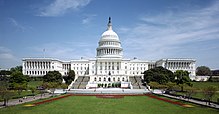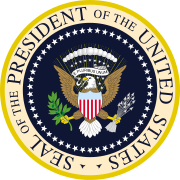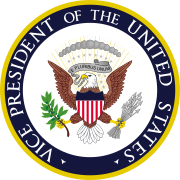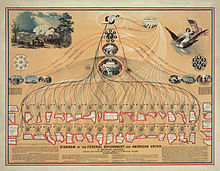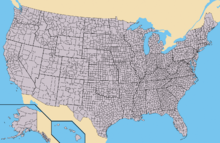Map of the contiguous United States with reservation lands excluded
Reservation lands in the Continental United States
Tribal sovereignty in the United States is the concept of the inherent authority of indigenous tribes to govern themselves within the borders of the United States. The U.S. federal government recognizes tribal nations as "domestic dependent nations" and has established a number of laws attempting to clarify the relationship between the federal, state, and tribal governments.
Native American sovereignty and the Constitution
The United States Constitution mentions Native American tribes three times:
- Article I, Section 2, Clause 3 states that "Representatives and direct Taxes shall be apportioned among the several States ... excluding Indians not taxed." According to Story's Commentaries on the U.S. Constitution, "There were Indians, also, in several, and probably in most, of the states at that period, who were not treated as citizens, and yet, who did not form a part of independent communities or tribes, exercising general sovereignty and powers of government within the boundaries of the states."
- Article I, Section 8 of the Constitution states that "Congress shall have the power to regulate Commerce with foreign nations and among the several states, and with the Indian tribes", determining that Indian tribes were separate from the federal government, the states, and foreign nations; and
- The Fourteenth Amendment, Section 2 amends the apportionment of representatives in Article I, Section 2 above.
These basic provisions have been changed or clarified by various federal laws over the history of the United States. Regulate historically meant facilitate,
rather than control or direct in the more modern sense. Therefore, the
Congress of these United States was to be the facilitator of commerce
between the states and the tribes.
These Constitutional provisions, and subsequent interpretations
by the Supreme Court (see below), are today often summarized in three
principles of U.S. Indian law:
- Territorial sovereignty: Tribal authority on Indian land is organic and is not granted by the states in which Indian lands are located.
- Plenary power doctrine: Congress, and not the Executive Branch or Judicial Branch, has ultimate authority with regard to matters affecting the Indian tribes. Federal courts give greater deference to Congress on Indian matters than on other subjects.
- Trust relationship: The federal government has a "duty to protect" the tribes, implying (courts have found) the necessary legislative and executive authorities to effect that duty.
Early history
The Marshall Trilogy, 1823–1832
Hassanamisco Nipmuc Indian Reservation Sign
The Marshall Trilogy is a set of three Supreme Court decisions in the
early nineteenth century affirming the legal and political standing of
Indian nations.
- Johnson v. M'Intosh (1823), holding that private citizens could not purchase lands from Native Americans.
- Cherokee Nation v. Georgia (1831), holding the Cherokee nation dependent, with a relationship to the United States like that of a "ward to its guardian".
- Worcester v. Georgia (1832), which laid out the relationship between tribes and the state and federal governments, stating that the federal government was the sole authority to deal with Indian nations.
Indian Appropriations Act of 1871
The Indian Appropriations Act of 1871
had two significant sections. First, the Act ended United States
recognition of additional Native American tribes or independent nations,
and prohibited additional treaties. Thus it required the federal
government no longer interact with the various tribes through treaties,
but rather through statutes:
That hereafter no Indian nation or tribe within the territory of the United States shall be acknowledged or recognized as an independent nation, tribe, or power with whom the United States may contract by treaty: Provided, further, that nothing herein contained shall be construed to invalidate or impair the obligation of any treaty heretofore lawfully made and ratified with any such Indian nation or tribe.
— Indian Appropriations Act of 1871
Before 1871, the United States had recognized the Indian Tribes as semi-independent.
The 1871 Act also made it a federal crime to commit murder,
manslaughter, rape, assault with intent to kill, arson, burglary, and
larceny within any Territory of the United States.
United States v. Kagama (1886)
The 1871 Act was affirmed in 1886 by the US Supreme Court, in United States v. Kagama, which affirmed that the Congress has plenary power
over all Native American tribes within its borders by rationalization
that "The power of the general government over these remnants of a race
once powerful ... is necessary to their protection as well as to the
safety of those among whom they dwell".
The Supreme Court affirmed that the US Government "has the right and
authority, instead of controlling them by treaties, to govern them by
acts of Congress, they being within the geographical limit of the United
States. ... The Indians owe no allegiance to a State within which their
reservation may be established, and the State gives them no
protection."
Empowerment of tribal courts, 1883
On April 10, 1883, five years after establishing Indian police powers
throughout the various reservations, the Indian Commissioner approved
rules for a "court of Indian offenses". The court provided a venue for
prosecuting criminal charges, but afforded no relief for tribes seeking
to resolve civil matters. The new courts' rules specifically targeted
tribal religious practices which it called "heathenish rites" and the
commissioner urged courts to "destroy the tribal relations as fast as
possible". Another five years later, Congress began providing funds to
operate the Indian courts.
While U.S. courts clarified some of the rights and
responsibilities of states and the federal government toward the Indian
nations within the new nation's first century, it was almost another
century before United States courts determined what powers remained
vested in the tribal nations. In the interim, as a trustee charged with
protecting their interests and property, the federal government was
legally entrusted with ownership and administration of the assets, land,
water, and treaty rights of the tribal nations.
The General Allotment Act (Dawes Act), 1887
Passed by Congress in 1887, the "Dawes Act" was named for Senator
Henry L. Dawes of Massachusetts, Chairman of the Senate's Indian Affairs
Committee. It came as another crucial step in attacking the tribal
aspect of the Indians of the time. In essence, the act broke up the land
of most all tribes into modest parcels to be distributed to Indian
families, and those remaining were auctioned off to white purchasers.
Indians who accepted the farmland and became "civilized" were made
American citizens. But the Act itself proved disastrous for Indians, as
much tribal land was lost and cultural traditions destroyed. Whites
benefited the most; for example, when the government made 2 million
acres (8,100 km2) of Indian lands available in Oklahoma,
50,000 white settlers poured in almost instantly to claim it all (in a
period of one day, April 22, 1889).
Twentieth-century developments
Revenue and Indian Citizenship acts, 1924
The Revenue Act of 1924 (43 Stat. 253) (June 2, 1924), also known as the Mellon tax bill, cut federal tax rates and established the U.S. Board of Tax Appeals, which was later renamed the United States Tax Court in 1942. The bill was named after U.S. Secretary of the Treasury Andrew Mellon. The Revenue Act was applicable to incomes for 1924. The bottom rate, on income under $4,000, fell from 1.5% to 1.125% (both rates are after reduction by the "earned income credit"). A parallel act, the Indian Citizenship Act of 1924 (43 Stat. 253, Ch. 233 (1924)), granted all non-citizen resident Indians citizenship.[16][17] Thus the Revenue Act declared that there were no longer any "Indians, not taxed" to be not counted for purposes of United States Congressional apportionment. President Calvin Coolidge signed the bill into law.
Iron Crow v. Oglala Sioux Tribe
In Iron Crow v. Oglala Sioux Tribe, the United States Supreme Court concluded that two Oglala Sioux
defendants convicted of adultery under tribal laws, and another
challenging a tax from the tribe, were not exempted from the tribal
justice system because they had been granted U.S. citizenship. It found
that tribes "still possess their inherent sovereignty excepting only
when it has been specifically taken from them by treaty or Congressional
Act". This means American Indians do not have exactly the same rights
of citizenship as other American citizens. The court cited case law from
a pre-1924 case that said, "when Indians are prepared to exercise the
privileges and bear the burdens of" sui iuris,
i.e. of one's own right and not under the power of someone else, "the
tribal relation may be dissolved and the national guardianship brought
to an end, but it rests with Congress to determine when and how this
shall be done, and whether the emancipation shall be complete or only
partial" (U.S. v. Nice, 1916). The court further determined, based on the earlier Lone Wolf v. Hitchcock case, that "It is thoroughly established that Congress has plenary authority
over Indians." The court held that, "the granting of citizenship in
itself did not destroy ... jurisdiction of the Indian tribal courts and
... there was no intention on the part of Congress to do so." The
adultery conviction and the power of tribal courts were upheld.
Further, the court held that whilst no law had directly
established tribal courts, federal funding "including pay and other
expenses of judges of Indian courts" implied that they were legitimate
courts. Iron Crow v. Oglala Sioux Tribe, 231 F.2d 89 (8th Cir. 1956) ("including pay and other expenses of judges of Indian courts").
Indian Reorganization Act, 1934
In 1934 the Indian Reorganization Act,
codified as Title 25, Section 476 of the U.S. Code, allowed Indian
nations to select from a catalogue of constitutional documents that
enumerated powers for tribes and for tribal councils.
Though the Act did not specifically recognize the Courts of Indian
Offenses, 1934 is widely considered to be the year when tribal
authority, rather than United States authority, gave the tribal courts
legitimacy.
Public Law 280, 1953
In 1953, Congress enacted Public Law 280,
which gave some states extensive jurisdiction over the criminal and
civil controversies involving Indians on Indian lands. Many, especially
Indians, continue to believe the law unfair because it imposed a system
of laws on the tribal nations without their approval.
In 1965 the United States Court of Appeals for the Ninth Circuit concluded that no law had ever extended provisions of the U.S. Constitution, including the right of habeas corpus,
to tribal members brought before tribal courts. Still, the court
concluded, "it is pure fiction to say that the Indian courts functioning
in the Fort Belknap Indian community are not in part, at least, arms of
the federal government. Originally they were created by federal
executive and imposed upon the Indian community, and to this day the
federal government still maintains a partial control over them." In the
end however, the Ninth Circuit limited its decision to the particular
reservation in question and stated, "it does not follow from our
decision that the tribal court must comply with every constitutional
restriction that is applicable to federal or state courts."
While many modern courts in Indian nations today have established full faith and credit
with state courts, the nations still have no direct access to U.S.
courts. When an Indian nation files suit against a state in U.S. court,
they do so with the approval of the Bureau of Indian Affairs.
In the modern legal era, courts and congress have, however, further
refined the often competing jurisdictions of tribal nations, states and
the United States in regard to Indian law.
In the 1978 case of Oliphant v. Suquamish Indian Tribe, the Supreme Court, in a 6–2 opinion authored by Justice William Rehnquist, concluded that tribal courts do not have jurisdiction over non-Indians (the Chief Justice of the Supreme Court at that time, Warren Burger, and Justice Thurgood Marshall
filed a dissenting opinion). But the case left unanswered some
questions, including whether tribal courts could use criminal contempt
powers against non-Indians to maintain decorum in the courtroom, or
whether tribal courts could subpoena non-Indians.
A 1981 case, Montana v. United States,
clarified that tribal nations possess inherent power over their
internal affairs, and civil authority over non-members within tribal
lands to the extent necessary to protect health, welfare, economic
interests or political integrity of the tribal nation.
Other cases of those years precluded states from interfering with
tribal nations' sovereignty. Tribal sovereignty is dependent on, and
subordinate to, only the federal government, not states, under Washington v. Confederated Tribes of Colville Indian Reservation (1980). Tribes are sovereign over tribal members and tribal land, under United States v. Mazurie (1975).
In Duro v. Reina, 495 U.S. 676
(1990), the Supreme Court held that a tribal court does not have
criminal jurisdiction over a non-member Indian, but that tribes "also
possess their traditional and undisputed power to exclude persons who
they deem to be undesirable from tribal lands. ... Tribal law
enforcement authorities have the power if necessary, to eject them.
Where jurisdiction to try and punish an offender rests outside the
tribe, tribal officers may exercise their power to detain and transport
him to the proper authorities." In response to this decision, Congress
passed the 'Duro Fix', which recognizes the power of tribes to
exercise criminal jurisdiction within their reservations over all
Indians, including non-members. The Duro Fix was upheld by the Supreme Court in United States v. Lara, 541 U.S. 193 (2004).
Tribal governments today
Great Seal of the Navajo Nation
Tribal courts
At
the dawn of the 21st century, the powers of tribal courts across the
United States varied, depending on whether the tribe was in a Public Law 280
state (Alaska, California, Minnesota, Nebraska, Oregon, and Wisconsin)
or not. Tribal courts maintain much criminal jurisdiction over their
members, and because of the Duro Fix, over non-member Indians regarding crime on tribal land. The Indian Civil Rights Act, however, limits tribal punishment to one year in jail and a $5,000 fine.
Tribal Courts have no criminal jurisdiction over non-Indians. In PL280
states, the state has been granted criminal and civil adjudicatory
jurisdiction over activities in Indian Country. In non-PL280 states,
Indian on Indian crime in Indian Country may be prosecuted in federal
court if the crime is one of those listed in the Major Crimes Act (18 USC §1153). Indian on non-Indian crime in Indian Country will be prosecuted in federal court, either from the MCA, or the Indian Country Crimes Act
(§1152) (unless the Indian was punished by the tribe). Non-Indian on
Indian crime in Indian Country will be prosecuted in federal court using
ICCA. Non-Indian on non-Indian crime in Indian Country will be prosecuted by the state.
While tribal nations do not enjoy direct access to U.S. courts to
bring cases against individual states, as sovereign nations they do
enjoy immunity against many lawsuits, unless a plaintiff is granted a waiver by the tribe or by congressional abrogation. The sovereignty extends to tribal enterprises and tribal casinos or gaming commissions. The Indian Civil Rights Act does not allow actions against an Indian tribe in federal court for deprivation of substantive rights, except for habeas corpus proceedings.
Tribal and pueblo governments today launch far-reaching economic
ventures, operate growing law enforcement agencies and adopt codes to
govern conduct within their jurisdiction but the United States retains
control over the scope of tribal law making. Laws adopted by Native
American governments must also pass the Secretarial Review of the Department of Interior through the Bureau of Indian Affairs.
Nation to nation: tribes and the federal government
When
the United States government formed, it replaced the British government
as the other sovereignty coexisting in America with the Native
Americans.
The U.S. constitution specifically mentions American Indians three
times. Article I, section 2, clause 3 and the fourteenth amendment
section 2 address the handling of "Indians not taxed" in the
apportionment of the seats of the House of Representatives according to
population and in so doing suggest that Indians need not be
taxed. In Article I section 8, clause 3, Congress is empowered to
"regulate commerce with foreign nations…states…and with the Indian
tribes." Technically, Congress has no more power over Indian nations
than it does over individual states. In the 1970s, Native American self-determination replaced Indian termination policy as the official United States policy towards Native Americans. Self-determination
promoted the ability of tribes to self-govern and make decisions
concerning their people. It has been argued that American Indian matters
should be handled through the United States Secretary of State, the official responsible for foreign policy.[citation needed] However, in dealing with Indian policy, a separate agency, the Bureau of Indian Affairs has been in place since 1824.
The idea that tribes have an inherent right to govern themselves
is at the foundation of their constitutional status — the power is not
delegated by congressional acts. Congress can, however, limit tribal
sovereignty. Unless a treaty or federal statute removes a power,
however, the tribe is assumed to possess it. Current federal policy in the United States recognizes this sovereignty and stresses the government-to-government relations between Washington, D.C., and the Native American tribes. However, most Native American land is held in trust by the United States,
and federal law still regulates the economic rights of tribal
governments and political rights. Tribal jurisdiction over persons and
things within tribal borders are often at issue. While tribal criminal
jurisdiction over Native Americans is reasonably well settled, tribes
are still striving to achieve criminal jurisdiction over non-Native
persons who commit crimes in Indian Country. This is largely due to the
Supreme Court's ruling in 1978 in Oliphant v. Suquamish Indian Tribe
that tribes lack the inherent authority to arrest, try and convict
non-Natives who commit crimes on their lands (see below for additional
discussion on this point.)
As a result of a pair of treaties, two tribal nations (the Cherokee and Choctaw) each have the right to send non-voting members to the United States House of Representatives (similar to a non-state US territory or the federal district), however neither tribe has ever exercised their right to do so since they were given the power in the 1830s.
Tribal state relations: sovereign within a sovereign
Otoe Tribal Seal
Another dispute over American Indian government is its sovereignty
versus that of the states. The federal U.S. government has always been
the government that makes treaties with Indian tribes – not individual
states. Article 1, Section 8 of the Constitution states that "Congress
shall have the power to regulate Commerce with foreign nations and among
the several states, and with the Indian tribes".
This determined that Indian tribes were separate from the federal or
state governments and that the states did not have power to regulate
commerce with the tribes, much less regulate the tribes. The states and
tribal nations have clashed over many issues such as Indian gaming,
fishing, and hunting. American Indians believed that they had treaties
between their ancestors and the United States government, protecting
their right to fish, while non-Indians believed the states were
responsible for regulating commercial and sports fishing. In the case Menominee Tribe v. United States
in 1968, it was ruled that "the establishment of a reservation by
treaty, statute or agreement includes an implied right of Indians to
hunt and fish on that reservation free of regulation by the state".
States have tried to extend their power over the tribes in many other
instances, but federal government ruling has continuously ruled in favor
of tribal sovereignty. A seminal court case was Worcester v. Georgia.
Chief Justice Marshall found that "England had treated the tribes as
sovereign and negotiated treaties of alliance with them. The United
States followed suit, thus continuing the practice of recognizing tribal
sovereignty. When the United States assumed the role of protector of
the tribes, it neither denied nor destroyed their sovereignty." As determined in the Supreme Court case United States v. Nice (1916), U.S. citizens are subject to all U.S. laws even if they also have tribal citizenship.
List of cases
- United States v. Holiday, 70 U.S. 407 (1866) (holding that a Congressional ban on selling liquor to the Indians was Constitutional)
- Sarlls v. United States, 152 U.S. 570 (1894) (holding that lager beer is not spiritous liquor nor wine within the meaning of those terms as used in Revised Statutes § 2139)
- In re Heff, 197 U.S. 488 (1905) (holding that Congress has the power to place the Indians under state law if it chooses, and the ban on selling liquor does not apply to Indians subject to the Allotment acts)
- Iron Crow v. Ogallala Sioux Tribe, 129 F. Supp. 15 (1955) (holding that tribes have power to create and change their court system and that power is limited only by Congress, not the courts)
- United States v. Washington (1974) also known as the Boldt Decision (concerning off-reservation fishing rights: holding that Indians had an easement to go through private property to their fishing locations, that the state could not charge Indians a fee to fish, that the state could not discriminate against the tribes in the method of fishing allowed, and that the Indians had a right to a fair and equitable share of the harvest)
- Wisconsin Potowatomies of Hannahville Indian Community v. Houston, 393 F. Supp. 719 (holding that tribal law and not state law governs the custody of children domiciled on reservation land)
- Oliphant v. Suquamish Indian Tribe, 435 U.S. 191 (1978) (holding that Indian tribal courts do not have inherent criminal jurisdiction to try and to punish non-Indians, and hence may not assume such jurisdiction unless specifically authorized to do so by Congress.)
- Merrion v. Jicarilla Apache Tribe, 455 U.S. 130 (1982) (holding that Indian Nations have the power to tax Non-Native Americans based on their power as a nation and treaty rights to exclude others; this right can be curtailed only by Congress.)
- American Indian Agricultural Credit Consortium, Inc. v. Fredericks, 551 F. Supp. 1020 (1982) (holding that federal, not state courts have jurisdiction over tribal members)
- Maynard v. Narrangansett Indian Tribe, 798 F. Supp. 94 (1992) (holding that tribes have sovereign immunity against state tort claims)
- Venetie I.R.A. Council v. Alaska, 798 F. Supp. 94 (holding that tribes have power to recognize and legislate adoptions)
- Native American Church v. Navajo Tribal Council, 272 F.2d 131 (holding that the First Amendment does not apply to Indian nations unless it is applied by Congress)
- Teague v. Bad River Band, 236 Wis. 2d 384 (2000) (holding that tribal courts deserve full faith and credit since they are the court of an independent sovereign; however, in order to end confusion, cases that are filed in state and tribal courts require consultation of both courts before they are decided.)
- Inyo County v. Paiute-Shoshone Indians (U.S. 2003) (holding that tribal sovereignty may override the search and seizure powers of a state)









